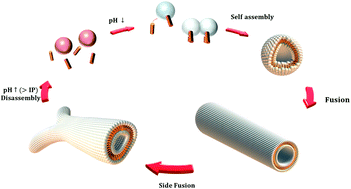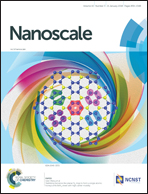Hierarchical self-assembly of zwitterionic dendrimer–anionic surfactant complexes into multiple stimuli-responsive dynamic nanotubes†
Abstract
Zwitterionic materials attract a wide range of attention due to their unique molecular structures and properties, which make them an interesting candidate to solve multiple problems e.g. in biological and industrial applications. Here, we show that the incorporation of zwitterions into supramolecular assemblies of ionic building blocks can be an effective way to design responsive nanostructures with well-defined morphologies. We report the hierarchical assembly of stimuli-responsive nanotubes with tunable diameters in aqueous solutions via the selective attachment of anionic surfactants to dendrimers with uniquely engineered zwitterionic peripheries. We found that the packing number of the dendrimer–surfactant hybrids can be reversibly controlled, which will trigger their assembly into tubular-like structures. These tubes can grow up to the micro-scale, their diameter is responsive to the ionic strength of the solution, and they can reversibly assemble/disassemble with a change in pH. To the best of our knowledge, this is the first example of dynamic nanotubes formed through controlled ionic interactions involving zwitterionic dendrimers in solution. This not only provides a bottom-up method to make stimuli responsive and dynamic tubes but also introduce a pathway to design complicated nanostructures by controlling the electrostatic interactions of building blocks using zwitterionic functionalities.



 Please wait while we load your content...
Please wait while we load your content...